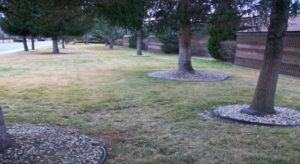Trees and turf aren’t an ideal mixture. An established stand of trees shades the ground to an extent that typically limits what grows below and most turf grass prefers full sun exposure. Trees have different requirements for water and nutrients than turf. Understanding these factors can help design a balanced and successful landscape.
How do I prepare a turf site for a tree?
The first step is to remove the turf and un-compact the soil (using a soil tiller) from the area to be planted with trees. Adding organic amendments to the soil during tilling is ideal. Edging should be installed about 2 to 4 feet from the trunk to keep grass from encroaching the trunk and to provide a buffer from weed eaters and mowers.

When turf is allowed to grow up to the trunk trees will be damaged
Preparing a site for a tree requires consideration to the routing and installation of an irrigation system for the tree, preferably a drip irrigation system if possible.
The sprinkler heads used to water the turf should be laid out or modified so the spray doesn’t strike the trunk of the tree. Repeated soaking of the bark will weaken it, making it easier for pests and disease to invade the tree.
Are there types of trees and turf that are better suited for one another?
Deep rooted tree species such as Sweetgum and Oak are better in turf than shallow-rooted varieties such as Silver Maple, Mulberry and Ash. Grasses with fescue in the mix will tolerate shade from trees better than non-fescue mixes.

A good example of tree rings in turf.
How do I best maintain a tree located in turf?
Because tree roots generally grow close to the ground surface, soil beneath the turf roots should be kept un-compacted and nutrient-rich so the tree roots are encouraged to root down. The root systems of trees in turf should be deep root fed to keep the tree roots from competing with the turf.
Trees require twice as much water as turf as a general rule. A tree planted in turf should have its own drip irrigation system for watering. Relying on lawn sprinklers to water a tree will usually result in the under-watering of the tree or the over-watering of the turf.
Needles from evergreen trees, when left to decompose on the grass, will usually raise the pH of the soil to a level that turf cannot tolerate.
Do not apply “weed and feed” fertilizers or weed killers near tree root systems. Be aware that in open areas, a tree’s root system can extend 3 to 5 times the diameter of the tree’s canopy.
Read more about trees and turf from the International Society of Arboriculture.
